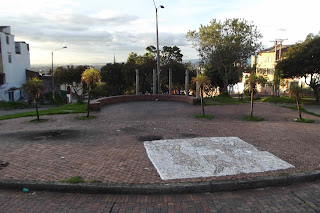 |
| A boy examines photos swinging in the wind. |
 |
| Carlos Castaño, el Bueno. |
Carlos Castaño, the name of the leader of the United Self-Defense Forces of Colombia, or AUC, is about the most notorious name in Colombian history thanks to the horrific rights abuses he ordered.
But there's another Carlos Castaño, who calls himself
'El Bueno' and hails from the other end of the political spectrum, who is carrying out Bogotá's most prominent one-man human rights campaign.
 |
| Alvaro Uribe, dictator? |
This Castaño, 50, came from a peasant family in the Antioquia region. At age 22 he joined the EPL guerrilla group, which reached a peace treaty with the government and demobilized in 1991. Castaño blames the EPL's leadership for accepting benefits from the government and selling out their principles. Just before the demobilization, however, Castaño said he had survived a massacre in which 6 peasants were murdered - one of many crimes and injustices which he blames on the Colombian government.
He became a farmer in Tolima. But says that in 2002 he and his family were forced to flee because of violence from right-wing paramilitaries, who may have answered to the other, EVIL Carlos Castaño, who was murdered by other paramilitaries in 2004.
 |
| Pedestrians ponder a photo celebrating Che Guevara. |
Then, Carlos Castaño, el bueno, fled to Bogotá, where he set began setting up his photo exhibitions. He displays hundreds of photos on long strings strung between trees and posts on the sidewalks. Most of the photos, he says, he took himself.
"I'm just out here giving a bit of truth to the people," Castaño says.
Castaño says he's been harassed by the police, who have confisticated his photos, searched his home and even accused him of being a terrorist. He considers himself only a truth-teller.

"If this is terrorism," he says, motioning to his photos, "then let's have more of it."
He hasn't had trouble recently, he says. The city's decision to ban cars from this stretch of Ave. Septima helped, as does the fact that Mayor Gustavo Petro was once a guerrilla himself - in his case in the M-19 movement.
Castaño's photos are a grab-bag of images, denouncing human rights violations, social injustices, harm to the environment - even technology (altho Castaño is on Facebook).

A man walks past and demands of Castaño: "Where are the photos of the FARC and ELN guerrillas' human rights violations?"
Castaño smiles back at him. "Don't worry," he replies, "the RCN and Caracol television and radio networks are transmitting plenty of that."
Both men correct. Castaño's photos definitely concentrate on denouncing the government and rightist forces, while celebrating socialist icons, particularly Che Guevara. Contradictorily, one image labels Colombia's democratically-elected Pres. Alvaro Uribe as a 'dictator,' while a nearby photo idolizes Guevara, a leader of Cuba's dictatorship.

Colombia's guerrillas and right-wing forces have all committed grevious human rights abuses. But, while virtually nobody defends the paramilitaries, a significant group of self-deceiving idealists, both here and abroad, persist in celebrating the guerrillas, despite all of their crimes against the poor. For an example, see
Mariana, the displaced woman begging across the street from Castaño.
A steady stream of passers-by stop and ponder Castaño's images. His low-tech exhibition likely gets many more visits than most websites about Colombian human rights. For Castaño, who travels around Colombia and even internationally displaying his pictures, the exhibition is not only a statement - it's also a living for him.
 |
| Police clash with demonstrators. |
"If you like the photos, how about contributing a few coins or a bill," he calls out, offering his collection can.
So, Castaño has joined the ranks of the professional displaced people, whom we see begging on Colombia's sidewalks displaying signs pleading 'Desplazados Por La Violencia. Favor Ayudarnos.' But turning into a lifetime beggar only perpetuates victimization and helplessness. Castaño may be living off of his tragedies, but at least he's also doing something constructive.
 |
| The message laments displacement of peasants. |
An idealist, Castaño expresses pessimism on Colombia's prospects for resolving its human rights problems and persistent injustices. In the FARC-government peace negotiations just starting up now in Havana, Cuba, Castaño expects the FARC leadership to sell out just as he accuses the EPL leaders of having done two decades ago.
 |
| Carlos, a bit ironically, hangs his photos on one of Bogotá's most commercial avenues. |
 |
| Carlos's photo of a policeman photographing Carlos while confisticating his photos. |
 |
| 'Donations please.' |
 |
| 'I fear the day that technology overtakes mankind.' Albert Einstein. |
 |
| Marx, Hitler, Einstein and Fidel Castro. A strange crowd at the Last Supper. |
By Mike Ceaser, of
Bogotá Bike Tours
 A prominent part of Bogotá's New Year's tradition are these espigas, or ears of wheat, which are supposed to bring good luck in the new year.
A prominent part of Bogotá's New Year's tradition are these espigas, or ears of wheat, which are supposed to bring good luck in the new year.  That Bogotá's mayor makes progress on problems like trash collection, traffic congestion, pollution, crime, poverty...and on and on.
That Bogotá's mayor makes progress on problems like trash collection, traffic congestion, pollution, crime, poverty...and on and on. 

























































